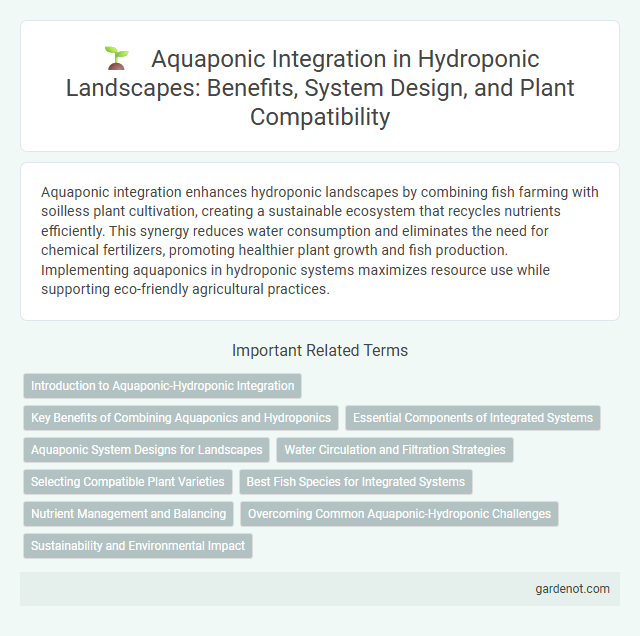Aquaponic integration enhances hydroponic landscapes by combining fish farming with soilless plant cultivation, creating a sustainable ecosystem that recycles nutrients efficiently. This synergy reduces water consumption and eliminates the need for chemical fertilizers, promoting healthier plant growth and fish production. Implementing aquaponics in hydroponic systems maximizes resource use while supporting eco-friendly agricultural practices.
Introduction to Aquaponic-Hydroponic Integration
Aquaponic-hydroponic integration combines fish farming with soilless plant cultivation, creating a sustainable ecosystem where nutrient-rich water from aquaculture supports hydroponic crops. This symbiotic system enhances resource efficiency by recycling fish waste as natural fertilizer, reducing water consumption by up to 90% compared to traditional agriculture. Implementing aquaponic integration optimizes growth rates and crop yields while promoting eco-friendly urban farming solutions.
Key Benefits of Combining Aquaponics and Hydroponics
Combining aquaponics and hydroponics maximizes resource efficiency by recycling nutrient-rich water from fish tanks directly to plant roots, reducing water consumption by up to 90% compared to traditional farming. This integration enhances crop yield and quality due to continuous nutrient supply and improved oxygenation, fostering faster plant growth. Fish provide a natural source of organic nutrients, minimizing the need for chemical fertilizers and promoting sustainable, eco-friendly agriculture.
Essential Components of Integrated Systems
Integrated aquaponic systems combine hydroponic plant cultivation with aquaculture, relying on essential components such as fish tanks, biofilters, and grow beds. The biofilter processes fish waste into nutrients, enabling plants to absorb these compounds for growth while purifying water for fish health. Efficient water circulation pumps and aeration devices maintain optimal oxygen levels, ensuring balanced biological function and sustainable production.
Aquaponic System Designs for Landscapes
Aquaponic system designs for landscapes combine hydroponic plant cultivation with aquaculture, creating a symbiotic environment where fish waste provides nutrients for plants, enhancing sustainability and reducing resource consumption. Innovative designs incorporate modular tanks and vertical grow beds, optimizing space efficiency and enabling seamless integration into urban and residential landscapes. Advanced filtration and water circulation technologies maintain optimal conditions for both aquatic life and vegetation, ensuring balanced ecosystem health and improved crop yield.
Water Circulation and Filtration Strategies
Aquaponic integration in hydroponic landscapes relies heavily on efficient water circulation systems that continuously move nutrient-rich water between fish tanks and plant grow beds, optimizing oxygen levels and nutrient uptake. Filtration strategies incorporate mechanical filters to remove solid waste and biofilters that convert toxic ammonia from fish waste into beneficial nitrates, ensuring water quality and promoting healthy plant growth. Maintaining balanced water pH and temperature through automated controls supports sustainable symbiosis between aquatic life and plants, enhancing overall system productivity.
Selecting Compatible Plant Varieties
Selecting compatible plant varieties for aquaponic integration ensures optimal nutrient uptake and symbiotic balance in hydroponic landscapes. Leafy greens like lettuce, spinach, and kale thrive alongside fruiting plants such as tomatoes and peppers, benefiting from fish-produced nutrients. Choosing species with similar pH and nutrient requirements maximizes system efficiency and promotes healthy plant growth.
Best Fish Species for Integrated Systems
Tilapia, catfish, and koi rank among the best fish species for integrated aquaponic systems due to their adaptability to various water conditions and rapid growth rates. These species efficiently convert fish waste into nutrients that promote healthy plant growth in hydroponic setups. Selecting robust fish like Nile tilapia enhances system stability, nutrient cycling, and overall productivity in aquaponic landscapes.
Nutrient Management and Balancing
Aquaponic integration in hydroponic landscapes combines aquaculture with soilless plant cultivation, optimizing nutrient cycling by using fish waste as a natural fertilizer. Precise nutrient management balances the ammonia excreted by fish, which beneficial bacteria convert into nitrates, providing essential nutrients for plant growth. Maintaining optimal pH levels and monitoring water quality ensures nutrient availability and prevents toxicity, supporting a sustainable, closed-loop ecosystem.
Overcoming Common Aquaponic-Hydroponic Challenges
Integrating aquaponics with hydroponic systems requires addressing nutrient imbalances and water quality management to optimize plant and fish health. Effective filtration and pH regulation techniques help overcome challenges related to ammonia toxicity and nutrient availability. Implementing robust monitoring systems enhances sustainability and ensures efficient resource use in combined aquaponic-hydroponic landscapes.
Sustainability and Environmental Impact
Aquaponic integration in hydroponic landscapes enhances sustainability by combining fish farming with plant cultivation, creating a closed-loop system that maximizes resource efficiency and minimizes waste. This symbiotic approach reduces water usage by up to 90% compared to traditional agriculture and eliminates the need for synthetic fertilizers, lowering environmental pollution. Implementing aquaponics supports biodiversity, decreases carbon footprint, and promotes resilient, eco-friendly urban agriculture solutions.
Aquaponic integration Infographic

 gardenot.com
gardenot.com